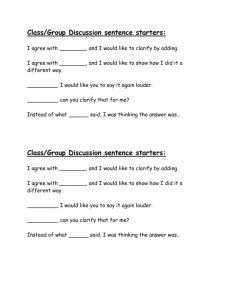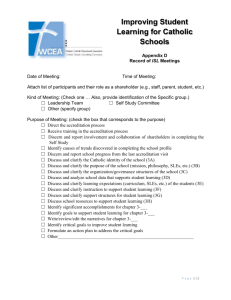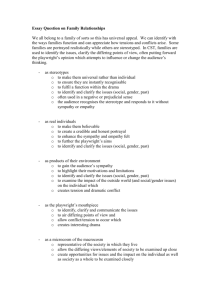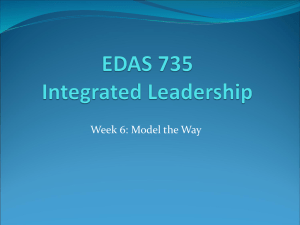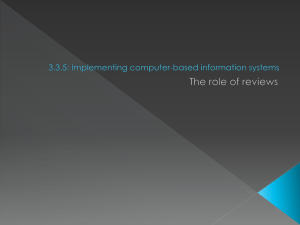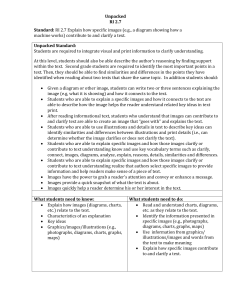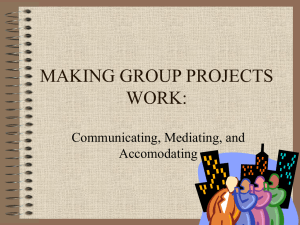What is Team Effectiveness?
advertisement
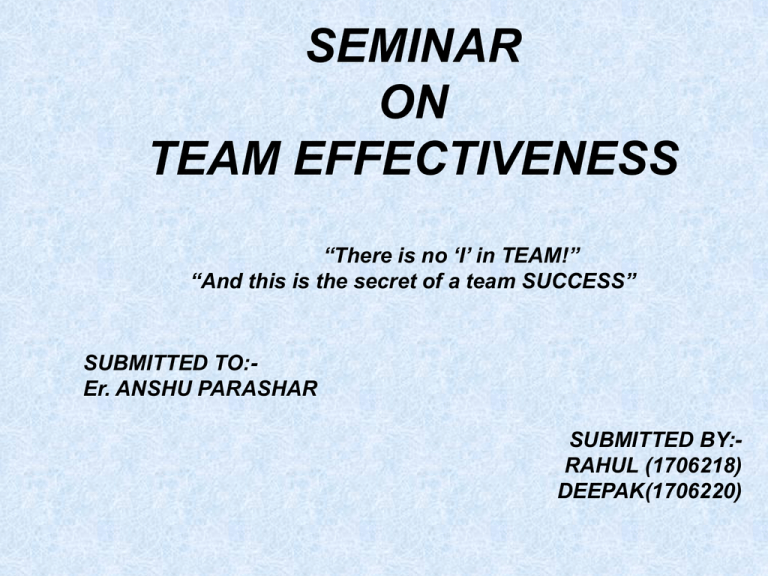
SEMINAR ON TEAM EFFECTIVENESS “There is no ‘I’ in TEAM!” “And this is the secret of a team SUCCESS” SUBMITTED TO:Er. ANSHU PARASHAR SUBMITTED BY:RAHUL (1706218) DEEPAK(1706220) Table of contents What is Team Effectiveness? Team Effectiveness using the scaled comparison. Aspects of excellent team. Maxims of team management Boehm’s Principles What does Team Effectiveness measure? Structural Elements Positive Interdependent Behaviors Four strategies to improve Team Effectiveness Clarify your team mission Set team goals! Create a plan Conduct progress reviews. TEAM EFFECTIVENESS MODEL WHAT IS TEAM EFFECTIVENESS? Team effectiveness refers to the system of getting people in a company or institution to work together effectively. TEAM EFFECTIVENESS USING THE SCALED COMPARISON Team Effectiveness is a proven and practical diagnostic tool for assessing team effectiveness and improving work group performance. Team Effectiveness gives the team a very precise and reliable consensus as to what team members see going well and what needs improvement. Cont.. • Team Effectiveness helps team members to very quickly pinpoint the gap between where they are and where they need to be. • With Team Effectiveness, all team members participate in team improvement through a sharing of their views about team performance and needed improvement. Cont.. • Unlike other diagnostic tools, Team Effectiveness works with teams as small as 5 to 7 members. ASPECTS OF EXCELLENT TEAM Balance and Coverage are two of the most important aspects of excellent teams:• Whenever team is out of balance, it is vulnerable. • Great teams need coverage across key positions with strong individual players. MAXIMS OF TEAM MANAGEMENT • A well managed project can succeed with the nominal engineering team. • A mismanaged project will almost never succeed, even with an expert team of engineers. • A well architected system can be built by a nominal team of software builders. • A poorly architected system will flounder even with an expert team of builders. BOEHM’S PRINCIPLES • The principle of top talent : Use better and fewer people • The principle of job matching : Fit the tasks to the skills and motivation of the people available. • The principle of career progression : An organization does best in the long run by helping its people to self-actualize. Cont.. • The principle of team balance : Select people who will complement and harmonize with one another. • The principle of phase out : Keeping a misfit on the team doesn’t benefit anyone. FACTORS AFFECTING TEAM EFFECTIVENESS:• The right mix of skills:- Bringing together the people having different skills that complement each other. • The right motivation:- Team effectiveness is directly related to the interest that team is having on the project. • The ability to solve conflicts without compromising the quality of the project. WHAT DOES TEAM EFFECTIVENESS MEASURE? Team Effectiveness assesses all of the major components of effective work groups, employing multiple statements for each of a number of basic elements. Some of the elements are :• Structural Elements • Positive Interdependent Behaviors • Structural Elements – Shared Team Vision – Clear Team Goals – Clear Team Roles – Effective Leadership Behavior • Positive Interdependent Behaviors – Effective Decision Making – Encouragement of Innovation – Effective Conflict Management – Natural Collaboration – Effective Meeting Management STRATEGIES TO IMPROVE TEAM EFFECTIVENESS Expectations from superiors and the demands of a competitive marketplace force many leaders to find new ways to do more work with fewer people. The task of building better teams and improving their effectiveness can be broken down into four simple and straightforward steps:Cont.. 1) Clarify Your Team Mission 2) Set Team Goals! 3) Create A Plan 4) Conduct Progress Reviews. CLARIFY YOUR TEAM MISSION Make sure that your mission is the team's reason for being - its purpose! For example:• If your team is responsible for new products, your mission might be to create innovative products and services that make the client's life easier and more enjoyable -- Or products and service that save the client money, Etc. SET TEAM GOALS! Every team should have definite objectives or goals. There are some guidelines for setting up the team goals. SETTING UP TEAM GOALS 1) The goals should support the team's mission or purpose. 2) Goals should be measurable. For example, instead of saying, we want to increase sales this month; a specific goal should be set. A measurable goal might be, this month we will increase sales by fifteen percent over last month's sales totals. 3) Goals should have a date. CREATE A PLAN A team plan is simply a written blueprint for the team's success. • spell's out the team's mission, • outlines the teams goals, and • It lays out a strategy for fulfilling the team mission and reaching the goals. • It states the responsibilities of each person on the team, what they do, and how they do it. • It should outline what each person does, and how he or she is accountable. CONDUCT PROGRESS REVIEWS These are simply meetings where the team members come together to discuss the team's results and future plans. ITEMS TO BE COVERED IN TEAM PROGRESS REVIEW • Check to make sure the team is effectively accomplishing its mission. • Review the team's goals and make necessary adjustments. This is a great time to keep the team goals out in front of everyone. • Set a date for the next Progress Review. • Review the team plan and determine if any updates or changes need to be made to make the team more effective. Talk about the things that are working well, and discuss what areas need to be improved. • Clarify responsibilities for each team member and the actions they need to take next. TEAM EFFECTIVENESS MODEL Teams can continuously improve their effectiveness by focusing on improving their functioning in five key areas: Goals, Roles, Procedures, Relationships and Leadership: • Goals: What the team aspires to achieve • Roles: The part each member plays in achieving the team goals • Procedures: The methods that help the team conduct its work together • Relationships: How the team members ‘get along” with each other • Leadership: How the leader supports the team in achieving results. CLEAR ROLES AND RESPONSIBILITIES • CLEAR CLEAR • PROCEDURES • FOR: PROCEDURES FOR • Solving Solving Problems Problems • and Making and Making • Decisions Decisions • Communicating • Managing Communicating Conflict Managing Conflict • Completing Tasks Completing Tasks • Planning Planning • Meetings • MeetingsManaging Change Managing Change • Evaluating • Performance Evaluating Performance Organization Structure Job Description Accountabilities CLEAR Resources PROCEDURES Tools and Equipment Qualifications FOR: Solving Problems and Making CLEAR GOALS Decisions Vision Communicating Mission Values Managing Conflict Plans Completing Tasks STRONG LEADERSHIP Planning Personal Credibility Meetings Clear Expectations Managing Change Clear Communication Engagement and Evaluating Involvement Performance Develop People and Team All members responsible and accountable Manage Change Recognition POSITIVE RELATIONSHIPS Mutual respect and trust Support Inclusion Involvement Value diversity Listening Feedback Okay with disagreement

